The World is Our Classroom: Field Trips to Plum Island and Wolf Hollow

A little bird. A hungry wolf. Sergei Prokofiev’s Peter and the Wolf springs to mind when we reflect on recent field trips by our elementary classes. But thankfully, nobody was swallowed on our adventures!
In May, our Lower and Upper elementary classes participated in two special field trips with wonderful naturalist guides. Below is a summary of our visits to Plum Island for bird banding, and Wolf Hollow—a preserve for gray wolves. Both of these visits were less than a 15 minute drive from the North Shore Montessori School in Rowley, Mass.
Bird Banding at Plum Island
On May 5, we visited the Parker River National Wildlife Refuge in Newbury, Mass. to witness a bird banding operation conducted by Massachusetts Audubon staff and volunteers.
The objective was to teach students about wintering and migrating bird species, including local raptors. After gathering at the Joppa Flats Education Center, we made our way to Plum Island—one of the East Coast’s most important stopovers for migratory birds.
After parking at the Sub-headquarters, our guides escorted us across the road to what seemed like a secret path; it was unmarked, but gated. We made our way a short walk through a clearing and to a little shack where a group of University of New Hampshire students were just finishing their visit.
Outside the little wooden bird banding shack was a small group of volunteers who were spending their morning checking a special temporary net every fifteen minutes for any species of bird that happened to fly into it.
While our group quietly waited for the volunteers to return, we visited with Ben, an Audubon employee who explained the banding process and purpose, as well as how bird data is collected and tracked in a national database.
At last, the volunteers trudged down the path victorious, with a small cotton sack in hand. Ben explained that the sack is used only once and keeps the birds calm. He carefully removed the unsuspecting White-throated Sparrow—a migratory songbird, allowing the students to ask questions as he examined, weighed, and placed a small numbered band on its ankle.
Ben told us that the bird was young, hatched less than a year ago, and that it will migrate to Vermont's Green Mountains or on to Canada for the summer months. The children were fascinated by the process, with some talking about their interest in a future career in science or working with nature.
After visiting the bird banding station, the students participated in a realistic role play called the Great Migration Challenge where they monitored a migratory bird and tracked its successes and failures along a virtual southward migration.
A Visit to Wolf Hollow
On May 27, we visited Wolf Hollow in Ipswich, Mass. The non-profit sanctuary for gray wolves was founded as the North American Wolf Foundation (NAWF) in 1988 by Paul C. Soffron.
Students were able to observe the wolves interacting with their pack-mates at close range, while learning many fun and interesting facts about the gray wolves, a threatened species in the wild.
Operations Manager Kevin Kenny led our educational program, and introduced us to seven wolves of various ages. You can see pictures of Gaia, Skully, Grendel, Qantaqa, Argus, Linnea and Akela, on the sanctuary’s website.
According to their website, Wolf Hollow seeks to:
- Raise awareness regarding the important role the wolf plays as a keystone species in promoting a healthy ecosystem
- Provide examples of how the pack co-exist as a family group, very similar to humans
- Display the dynamics and hierarchy amongst the pack through observable behavior cues
- Discuss the biology of the wolf, as well as the evolution/domestication of modern dogs
- Provide a glimpse into the history of man's interaction with wolves and the challenges we face at present to protect the wolf as a species
The students thoroughly enjoyed learning about the wolves, and were amazed to learn that the wolves do not eat every day, and that a two-year-old is considered an adult!
Experiential learning and connecting to our natural world are key tenets of a Montessori education. Given the abundance of wildlife sanctuaries and parks in our region and our small class sizes, North Shore Montessori School students are fortunate to have a number of field trips throughout the year.
We are grateful to the teachers for planning these wonderful visits that connect to the classroom curriculum, as well as to the parents who take time to join us as drivers and chaperones.


















